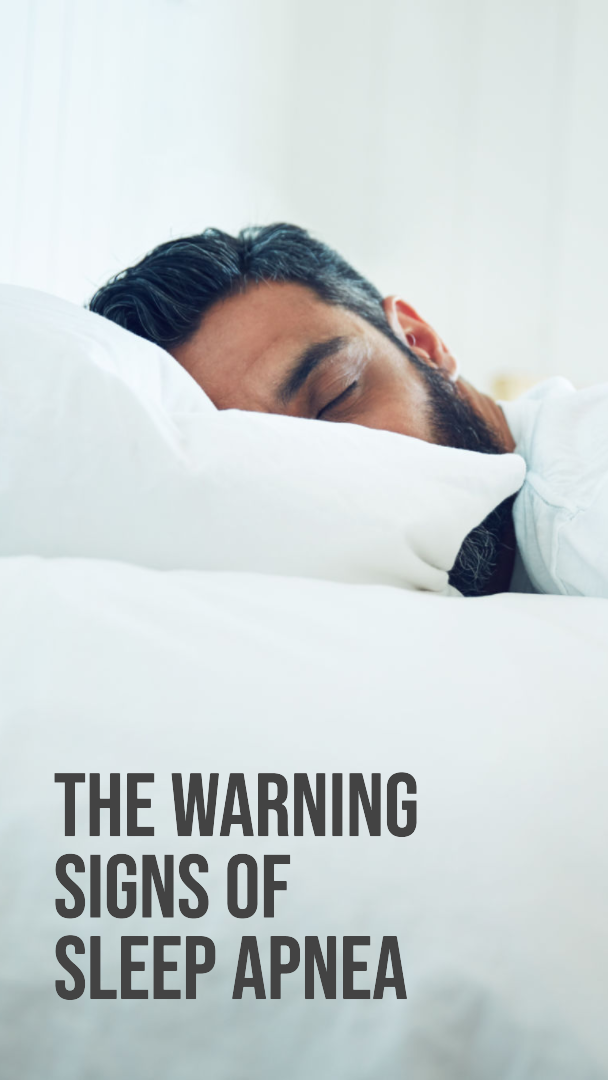Sleep Apnea Warning Signs
The Common Warning Signs of Sleep Apnea
- Loud, frequent snoring: Snoring can be a sign of airway obstruction during sleep, which may indicate sleep apnea.
- Gasping or choking during sleep: These episodes occur when the body struggles to resume normal breathing after a temporary pause caused by sleep apnea.
- Excessive daytime sleepiness: Sleep apnea can lead to sleep fragmentation, causing constant fatigue even after a full night’s sleep.
- Frequent awakenings or insomnia: Sleep apnea can cause repeated awakenings during the night, leading to difficulty staying asleep or insomnia.
- Morning headaches: Oxygen deprivation during sleep apnea episodes can cause blood vessels in the brain to dilate, resulting in morning headaches.
The Additional Warning Signs of Sleep Apnea
- Nocturia (frequent nighttime urination): Sleep apnea can cause increased urine production due to low oxygen levels, leading to the need for frequent urination during the night.
- Difficulty concentrating or memory problems: Sleep apnea can negatively impact cognitive function, causing issues with focus and memory.
- Irritability, mood swings, or depression: The chronic sleep deprivation experienced by individuals with sleep apnea can contribute to emotional instability and increased sensitivity to stress.
- Sexual dysfunction or decreased libido: Sleep apnea can lead to hormonal imbalances and fatigue, resulting in sexual dysfunction or reduced sex drive.
- Dry mouth or sore throat upon waking: Airway obstruction during sleep can cause mouth breathing, leading to dryness and discomfort in the mouth and throat.
Sleep apnea is a common sleep disorder characterized by repeated interruptions in breathing during sleep. It affects millions of people worldwide and, if left untreated, can have severe health consequences. Understanding the warning signs of sleep apnea is crucial for early detection and intervention. In this essay, we will discuss the various types of sleep apnea, common and additional warning signs, risk factors, consequences of untreated sleep apnea, and diagnosis and treatment options.
Types of Sleep Apnea
There are three main types of sleep apnea: Obstructive sleep apnea (OSA), Central sleep apnea (CSA), and Complex sleep apnea syndrome.
Obstructive Sleep Apnea (OSA)
OSA is the most common type of sleep apnea, affecting approximately 80-90% of sleep apnea patients. It occurs when the muscles in the back of the throat fail to keep the airway open, resulting in partial or complete obstruction during sleep. This obstruction leads to a temporary pause in breathing, which can happen hundreds of times per night.
Central Sleep Apnea (CSA)
CSA is less common, affecting only about 10% of sleep apnea patients. It occurs when the brain fails to send the proper signals to the muscles that control breathing, resulting in the cessation of breathing during sleep. Unlike OSA, CSA is not caused by a physical obstruction but rather a failure of the brain to communicate effectively with the respiratory system.
Complex Sleep Apnea Syndrome
Complex sleep apnea syndrome, also known as treatment-emergent central sleep apnea, is a combination of both OSA and CSA. It occurs in a small percentage of patients who experience central apneas after starting treatment for OSA, typically with continuous positive airway pressure (CPAP) therapy.
Common Warning Signs of Sleep Apnea
There are several common warning signs that could indicate the presence of sleep apnea.
Snoring
Snoring is often one of the first signs of sleep apnea. While not all snoring is related to sleep apnea, loud, frequent snoring accompanied by choking or gasping sounds can be indicative of the condition. For example, imagine a spouse who constantly complains about their partner’s snoring and even records it to prove how disruptive it is. In such cases, it’s essential to consider sleep apnea as a potential cause.
Gasping or Choking During Sleep
People with sleep apnea may experience episodes of gasping or choking during sleep as their body attempts to resume normal breathing. These episodes can be frightening for both the person experiencing them and anyone who witnesses them. A real-life example could be a parent who checks on their child at night and notices them gasping for air, which can be an alarming experience.
Excessive Daytime Sleepiness
Excessive daytime sleepiness is another common sign of sleep apnea. Sleep fragmentation caused by apnea episodes can lead to a feeling of constant fatigue, even after a full night’s sleep. It’s essential to differentiate between normal tiredness and excessive sleepiness, as the latter can significantly impact a person’s quality of life. For instance, someone who consistently dozes off at work, during meetings, or while driving might have an underlying sleep disorder like sleep apnea.
Frequent Awakenings or Insomnia
Sleep apnea can cause frequent awakenings during the night, leading to insomnia or difficulty staying asleep. Individuals may not even be aware of these awakenings but may notice that they never feel well-rested. A person with sleep apnea might toss and turn throughout the night or struggle to fall back asleep after waking up, further contributing to daytime sleepiness.
Morning Headaches
Morning headaches can be another warning sign of sleep apnea. The oxygen deprivation caused by apnea episodes can lead to blood vessels in the brain dilating, resulting in headaches upon waking. While not all morning headaches are related to sleep apnea, persistent headaches, especially in combination with other warning signs, should be taken seriously. Consider someone who wakes up with a headache almost every morning and dismisses it as a normal part of their routine. In reality, it could be an indicator of an underlying sleep disorder like sleep apnea.
Additional Warning Signs of Sleep Apnea
Apart from the common warning signs, there are additional symptoms that can indicate sleep apnea.
Nocturia (Frequent Nighttime Urination)
Sleep apnea can cause nocturia, or the need to urinate frequently during the night. This is due to the increased production of urine when the body experiences low oxygen levels. A person with sleep apnea might find themselves waking up multiple times per night to use the restroom, disrupting their sleep even further.
Difficulty Concentrating or Memory Problems
Sleep apnea can negatively impact cognitive function, leading to difficulty concentrating or memory problems. People with untreated sleep apnea may struggle to focus on tasks, forget important information, or experience general brain fog. This can significantly impact daily activities and work performance, causing frustration and anxiety.
Irritability, Mood Swings, or Depression
Untreated sleep apnea can also affect mental health, leading to irritability, mood swings, or depression. The chronic sleep deprivation experienced by individuals with sleep apnea can contribute to emotional instability and increased sensitivity to stress. For example, someone who was once easygoing might become irritable and short-tempered due to the effects of sleep apnea on their mood.
Sexual Dysfunction or Decreased Libido
Sleep apnea can also result in sexual dysfunction or a decreased libido. This can be due to the hormonal imbalances and fatigue associated with the disorder. As a result, relationships can suffer, leading to increased tension and dissatisfaction.
Dry Mouth or Sore Throat Upon Waking
Individuals with sleep apnea may experience a dry mouth or sore throat upon waking due to mouth breathing during sleep. This can be a result of airway obstruction, which forces the person to breathe through their mouth, causing dryness and discomfort.
Risk Factors for Sleep Apnea
There are several risk factors that can increase the likelihood of developing sleep apnea.
Obesity
Obesity is a significant risk factor for sleep apnea, particularly OSA. Excess weight, especially around the neck, can put pressure on the airway and contribute to its collapse during sleep.
Age
The risk of sleep apnea increases with age, as muscle tone tends to decrease and soft tissues in the throat become more prone to collapse.
Gender
Men are more likely to develop sleep apnea than women, although the risk for women increases after menopause.
Family History
A family history of sleep apnea can increase the likelihood of developing the condition, suggesting a genetic predisposition.
Alcohol and Tobacco Use
Alcohol and tobacco use can contribute to sleep apnea. Alcohol relaxes the throat muscles, increasing the risk of airway collapse, while smoking can cause inflammation and fluid retention in the airway.
Medical Conditions
Certain medical conditions, such as hypothyroidism, acromegaly, or tonsil enlargement, can increase the risk of sleep apnea.
Consequences of Untreated Sleep Apnea
If left untreated, sleep apnea can have severe health consequences.
Cardiovascular Risks
Sleep apnea is associated with an increased risk of cardiovascular problems, such as hypertension, stroke, and heart failure. This is due to the stress that repeated oxygen deprivation puts on the cardiovascular system.
Metabolic Risks
Untreated sleep apnea can also lead to metabolic
issues, such as insulin resistance and type 2 diabetes. The sleep fragmentation and hormonal imbalances caused by sleep apnea can negatively impact glucose metabolism and insulin sensitivity.
Metabolic Syndrome
Sleep apnea has been linked to metabolic syndrome, a cluster of conditions that includes high blood pressure, high blood sugar, excess body fat around the waist, and abnormal cholesterol levels. Metabolic syndrome increases the risk of heart disease, stroke, and diabetes.
Cognitive and Mental Health Risks
Untreated sleep apnea can impair cognitive function, leading to memory problems, difficulty concentrating, and poor decision-making. Additionally, sleep apnea can increase the risk of developing depression and anxiety due to the chronic sleep deprivation and emotional strain associated with the condition.
Quality of Life and Relationships
Sleep apnea can significantly impact a person’s quality of life and relationships. The constant fatigue and mood changes can lead to poor work performance, strained personal relationships, and a reduced overall enjoyment of life.
Diagnosis and Treatment
There are several diagnostic tests and treatment options available for sleep apnea.
Diagnostic Tests
Polysomnography (PSG)
Polysomnography is an overnight sleep study that monitors various physiological parameters, such as brain activity, eye movements, heart rate, and blood oxygen levels. This test can help determine the presence and severity of sleep apnea.
Home Sleep Apnea Testing (HSAT)
HSAT is a simplified sleep study that can be performed at home. It typically monitors breathing patterns, oxygen levels, and heart rate. While not as comprehensive as polysomnography, HSAT can be a more convenient and cost-effective option for some patients.
Treatment Options
Continuous Positive Airway Pressure (CPAP) Therapy
CPAP therapy is the most common and effective treatment for sleep apnea. It involves wearing a mask over the nose and/or mouth during sleep, which delivers a continuous stream of pressurized air to keep the airway open.
Oral Appliances
Oral appliances, such as mandibular advancement devices, can help treat mild to moderate sleep apnea by repositioning the lower jaw and tongue to maintain an open airway during sleep.
Lifestyle Modifications
Lifestyle modifications, such as weight loss, exercise, and avoiding alcohol and tobacco, can help improve sleep apnea symptoms and overall health.
Surgical Interventions
In some cases, surgical interventions may be necessary to treat sleep apnea. These can include uvulopalatopharyngoplasty (UPPP), genioglossus advancement, or maxillomandibular advancement, among others.
Recognise the Signs
Recognizing sleep apnea warning signs is crucial for early detection and intervention. If you or someone you know is experiencing any of these symptoms, it’s essential to seek professional help. Proper diagnosis and treatment can significantly improve health outcomes and quality of life for individuals living with sleep apnea. Don’t let sleep apnea go undiagnosed—addressing this common sleep disorder can lead to a better night’s sleep and a healthier, happier life.




